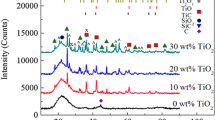It is established that the cooling rate after hot pressing controls the crystallization and decrystallization in Si3N4–TiO2 (TiH2) composites. The critical cooling rate is 30 deg/min for Si3N4–TiO2 composites and 50 deg/min for Si3N4–TiH2 composites. It is shown that conductivity responds to the microstructural evolution of the composites as defect centers appear. The defects are located at trapping levels of (0.4 ± 0.05)–(1.3 ± 0.05) eV and differ in mutually perpendicular directions. The best combination of properties is shown by the composites with a monotrapping level with an activation energy of 0.8 ± 0.05 eV. These energy levels supposedly belong to the thin layer of amorphous silicon. The nascent defects are probably point defects or an association of point defects because of the low sensitivity of mechanical properties and strong response of conductivity to the cooling rate.
Similar content being viewed by others
References
A. V. Rzhanov, Silicon Nitride Ceramics in Electronics [in Russian], Nauka, Novosibirsk (1982), p. 200.
D. Sutor and G. S. Fischman, “Densification and sintering kinetics in sintered silicon nitride,” J. Am. Ceram. Soc., 75, No. 5, 1063–1067 (1992).
A. L. Petrov, A. A. Gavrilyuk, and S. M. Zubritskii, Structure and Properties of Disordered Solids: Manual [in Russian], Irkutsk (2004).
J. E. Wectin, P. L. Pratt, and B. C. Steele, “Crystallization of grain boundary phases in hot-pressed silicon nitride materials. Part 1. Preparation and characterization materials,” J. Mater. Sci., No. 13, 2137–2146 (1978).
V. Ya. Petrovskii, “Role of liquid phase in the formation of sialon ceramic properties,” in: CERAMICS’45, 41–50 (1994).
S. Hayashi, T. Hirai, and R. Hiraga, “Microstructure of Si3N4–TiN composites prepared by chemical-vapor deposition,” J. Mater. Sci., No. 17, 3336–3340 (1982).
J. Zhang, J. S. Yuan, Y. Ma, and A. S. Oates, “Design optimization of stacked layer dielectrics for minimum gate leakage currents,” Solid-State Electronics, No. 44, 2165–6170 (2000).
C. Kawai and A. Yamakawa, Ceramics Int., No. 24, 135–138 (1998).
R. Sabia and L. Ukrainczyk, “Surface chemistry of SiO2 and TiO2 ± SiO2 glasses as determined by titration of soot particles,” J. Noncrystal. Sol., 277, 1–9 (2000).
M. A. Kuzenkova and V. V. Ivzhenko, “Effect of titanium hydride additions on the structure and properties of titanium nitride ceramics,” in: Production Methods, Properties, and Applications of Nitrides [in Russian], Zinatne, Riga (1984), p. 118.
V. Ya. Petrovskii and V. Skorokhod, “Physical principles and technological aspects of the production of gradient composites based on oxygen-free ceramics,” Powder Metall. Met. Ceram., 38, No. 3–4, 115–125 (1999).
G. G. Gnesin, V. M. Kirilenko, and V. Ya. Petrovskii, “Quality control of hot-pressed silicon nitride dielectric materials,” Powder Metall. Met. Ceram., 21, No. 3, 204–208 (1982).
G. V. Samsonov and I. M. Vinnitskii, Refractory Compounds [in Russian], Metallurgiya, Moscow (1976), p. 101
R. A. Andrievskii and I. I. Spivak, Silicon Nitride and Materials on Its Basis [in Russian], Metallurgiya, Moscow (1984), p. 368.
Minerals: Handbook, Vol. 2, Issue 2. Simple Oxides [in Russian], Nauka, Moscow (1965), p. 67.
O. A. Golikova, “Icosahedral borides and amorphous boron,” Fiz. Tekh. Polyprov., 26, No. 9, 1604–1611 (1992).
N. F. Mott and E. A. Davis, Electronic Processes in Noncrystalline Materials, Clarendon Press, Oxford (1979).
H. S. Thorp and R. I. Sharif, “Electrical conductivity in hot-pressed nitrogen ceramics,” J. Mater. Sci., 11, No. 8, 1494–1500 (1976).
H. S. Thorp and R. I. Sharif, “D. C. electrical properties of hot-pressed nitrogen ceramics,” J. Mater. Sci., 13, 441–449 (1978).
O. A. Golikova, “Structure of amorphous hydrogenated silicon films deposited by the decomposition of silan in the d. c. magnetic field,” Fiz. Tekh. Polyprov., 31, No. 7, 816–819 (1997).
O. A. Golikova and M. M. Kazanin, “Films of amorphous hydrogenated silicon with high photosensitivity,” Fiz. Tekh. Polyprov., 33, No. 1, 110 –113 (1999).
V. A. Grishchenko, Yu. N. Novikov, A. V. Shaposhnikova, et al., “Numerical modeling of intrinsic defects in SiO2 and Si3N4,” Fiz. Tekh. Polyprov., 35, No. 9, 1041–1049 (2001).
Author information
Authors and Affiliations
Corresponding author
Additional information
Translated from Poroshkovaya Metallurgiya, Vol. 49, No. 1–2 (471), pp. 124–137, 2010.
Rights and permissions
About this article
Cite this article
Chernyakova, I.V., Zdolnik, S.N. & Petrovskii, V.Y. Microstructure and conductivity of hot-pressed Si3N4–TiO2 (TiH2) composites cooled at different rates. Powder Metall Met Ceram 49, 99–109 (2010). https://doi.org/10.1007/s11106-010-9208-6
Received:
Published:
Issue Date:
DOI: https://doi.org/10.1007/s11106-010-9208-6



